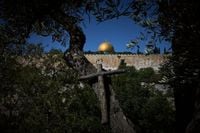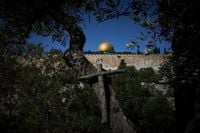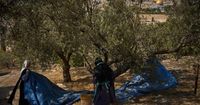Every October, as the sun rises over Jerusalem’s Old City, a small but determined group of monks and nuns gather on the storied slopes of the Mount of Olives. They’re there for a tradition as old as the hills themselves: harvesting olives in the very gardens where, according to the Gospel, Jesus spent his last night before being led away to crucifixion. This year, the olive harvest unfolded against the backdrop of a fragile ceasefire in the two-year Israel-Hamas war, casting a rare glimmer of hope over a region too often marked by conflict.
Despite the echoes of turmoil, the ancient olive trees—some centuries old—stood as silent witnesses to both the violence and the resilience of those who tend them. According to the Associated Press, the harvest this year was shadowed by the memory of missile attacks that have rattled the Holy Land, yet the monks and nuns pressed on, their work a living testament to faith and perseverance.
“The land is a gift and the sign of a divine presence,” reflected the Rev. Diego Dalla Gassa, a Franciscan priest charged with overseeing the harvest at the hermitage beside Gethsemane. For Dalla Gassa and the other mostly Catholic congregations on the Mount of Olives, the harvest is not just about sustenance or commerce. It’s a form of prayer, a way to inhabit the holy sites both physically and spiritually. “To be the custodian of holy sites doesn’t mean only to guard them, but to live them, physically but also spiritually,” he explained. “It’s really the holy sites that guard us.”
Early on a crisp October morning, Dalla Gassa swapped his traditional habit for more practical attire—a T-shirt and shorts, though he kept an olive wood cross around his neck. He joined a motley crew of volunteers: Israeli Jews, visiting Italian law enforcement officers, and pilgrims from across Europe. Together, they picked black and green olives by hand and with tiny rakes, dropping the fruit onto nets stretched beneath the trees. According to AP reporting, it takes up to 10 kilograms (22 pounds) of olives to produce a single liter (34 ounces) of extra-virgin olive oil. When the nets were full, Dalla Gassa donned ear covers and fired up the modern olive press, filling the air with the pungent, grassy aroma of freshly pressed oil.
Up the hill, the Benedictine sisters in their monastery followed a rhythm as old as monasticism itself: sixteen hours of daily work, contemplative walks through the gardens, and prayer. For Sister Marie Benedicte, who has lived in the Benedictine monastery atop the Mount of Olives for over two decades, the harvest is a spiritual retreat. “It’s easy to pray while picking and nature is so beautiful,” she said, cradling a kitten she’d named Petit Chat. “It’s like a retreat time.”
Her fellow sister, Colomba, originally from the Philippines, keeps watch over the olive oil supply for the church lamps, ensuring there’s always enough to keep the flames burning by the tabernacle. The sisters, now only half a dozen in number, dedicate most of their harvest to their own needs—both culinary and sacramental. Olive oil, blessed during the annual Chrism Mass, is used for everything from anointing the sick to blessing the baptized and consecrating new altars.
The olive tree’s deep roots in this desert region are not just agricultural but symbolic. For millennia, olives have been at the heart of life in the Holy Land—and, at times, at the heart of conflict. According to AP, olive groves have often become flashpoints in disputes between Palestinians and Jewish settlers, particularly in the West Bank, which Israel occupied in 1967 along with East Jerusalem, where the Mount of Olives is located. Yet, for the religious communities on the hill, the harvest remains untouched by commerce or politics. Their oil is not for sale; it’s for sustenance, sacrament, and the soul.
The harvest itself is steeped in spiritual meaning. “The olive has a vocation,” Dalla Gassa explained to AP reporters as he worked the press. “It must be pressed and then we rejoice in the ‘green gold.’” Squeezing a plump green olive between his fingers, he reflected on the parallels between the olive’s journey and his own spiritual path. “The olive is only good when pressed. It’s the same for us.” The act of seeking out every last olive, even those hidden deep within the branches, became a metaphor for divine grace: “In picking the olives, we learn how we are picked. We go looking for that last olive—that’s what God does with us, even those who are a bit hard to reach.”
Volunteers who joined the harvest described it as an experience that transcended mere physical labor. “The garden is very special. It’s full of spirituality and holiness,” said Ilana Peer-Goldin, an Israeli volunteer with a background in Jewish, Catholic, and Buddhist practices. Teresa Penta, a native of Puglia, Italy—one of the Mediterranean’s premier olive-producing regions—spoke of the “eternal charm” of the place. She noted that the installation of the modern olive press in recent years had restored Gethsemane to its original function, deepening the spiritual resonance of the harvest.
This year, however, nature was less generous. The olive yield was meager, a result of drought and fierce springtime winds that damaged the delicate blossoms. To compensate, some congregations sent their olives to the monastery of Latrun, situated halfway between Jerusalem and Tel Aviv, for processing. But tragedy struck there, too: thousands of Latrun’s own olive trees and vines were destroyed by a devastating fire in the spring of 2025.
Brother Athanase, a Trappist monk at Latrun, described the dual purpose of their agricultural work. While oil and wine production helps the friars make a living, the ultimate goal is spiritual. “To create the empty space while working with repetitive gesture, to be completely available to our Lord, Jesus Christ,” he said. “It’s a life to be received completely.”
For the volunteers, monks, and nuns who gather each year on the Mount of Olives, the harvest is more than a seasonal task. It is a ritual that binds them to the land, to history, and to each other—a living prayer in a place where the sacred and the everyday are forever intertwined.


